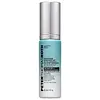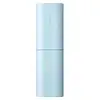What's inside
What's inside
 Key Ingredients
Key Ingredients

 Benefits
Benefits

 Concerns
Concerns

 Ingredients Side-by-side
Ingredients Side-by-side

Water
Skin ConditioningRicinus Communis Seed Oil
MaskingButylene Glycol
HumectantIsostearyl Neopentanoate
EmollientGlycerin
HumectantSodium Hyaluronate
HumectantLactic Acid
BufferingSphingolipids
EmollientAcrylates/C10-30 Alkyl Acrylate Crosspolymer
Emulsion StabilisingAmylopectin
Phospholipids
Skin ConditioningCarbomer
Emulsion StabilisingPotassium Sorbate
PreservativeEthylhexylglycerin
Skin ConditioningSodium Hydroxide
BufferingAscorbyl Palmitate
AntioxidantTocopherol
AntioxidantLecithin
EmollientSodium Benzoate
MaskingMalachite Extract
AntioxidantLithothamnion Calcareum Extract
Skin ConditioningSodium Citrate
BufferingPentylene Glycol
Skin ConditioningIsostearyl Alcohol
EmollientXanthan Gum
EmulsifyingHydrogenated Palm Glycerides Citrate
EmollientDimethicone
EmollientCI 42090
Cosmetic ColorantPhenoxyethanol
PreservativeWater, Ricinus Communis Seed Oil, Butylene Glycol, Isostearyl Neopentanoate, Glycerin, Sodium Hyaluronate, Lactic Acid, Sphingolipids, Acrylates/C10-30 Alkyl Acrylate Crosspolymer, Amylopectin, Phospholipids, Carbomer, Potassium Sorbate, Ethylhexylglycerin, Sodium Hydroxide, Ascorbyl Palmitate, Tocopherol, Lecithin, Sodium Benzoate, Malachite Extract, Lithothamnion Calcareum Extract, Sodium Citrate, Pentylene Glycol, Isostearyl Alcohol, Xanthan Gum, Hydrogenated Palm Glycerides Citrate, Dimethicone, CI 42090, Phenoxyethanol
Water
Skin ConditioningButylene Glycol
HumectantDipropylene Glycol
HumectantGlycerin
HumectantSqualane
Emollient1,2-Hexanediol
Skin ConditioningAmmonium Acryloyldimethyltaurate/Vp Copolymer
Propanediol
SolventCarbomer
Emulsion StabilisingCetearyl Alcohol
EmollientTromethamine
BufferingPolyglyceryl-3 Methylglucose Distearate
EmulsifyingDextrin
AbsorbentHydrogenated Lecithin
EmulsifyingEthylhexylglycerin
Skin ConditioningParfum
MaskingGlyceryl Stearate Citrate
EmollientDisodium EDTA
Betaine
HumectantHydrolyzed Hyaluronic Acid
HumectantBeta-Glucan
Skin ConditioningXylitylglucoside
HumectantAnhydroxylitol
HumectantXylitol
HumectantLactobacillus Ferment Lysate
Skin ConditioningGlucose
HumectantTocopherol
AntioxidantMagnesium Chloride
Tetradecyl Aminobutyroylvalylaminobutyric Urea Trifluoroacetate
Skin ConditioningUndaria Pinnatifida Extract
Skin ConditioningWater, Butylene Glycol, Dipropylene Glycol, Glycerin, Squalane, 1,2-Hexanediol, Ammonium Acryloyldimethyltaurate/Vp Copolymer, Propanediol, Carbomer, Cetearyl Alcohol, Tromethamine, Polyglyceryl-3 Methylglucose Distearate, Dextrin, Hydrogenated Lecithin, Ethylhexylglycerin, Parfum, Glyceryl Stearate Citrate, Disodium EDTA, Betaine, Hydrolyzed Hyaluronic Acid, Beta-Glucan, Xylitylglucoside, Anhydroxylitol, Xylitol, Lactobacillus Ferment Lysate, Glucose, Tocopherol, Magnesium Chloride, Tetradecyl Aminobutyroylvalylaminobutyric Urea Trifluoroacetate, Undaria Pinnatifida Extract
 Reviews
Reviews

Ingredients Explained
These ingredients are found in both products.
Ingredients higher up in an ingredient list are typically present in a larger amount.
Butylene Glycol (or BG) is used within cosmetic products for a few different reasons:
Overall, Butylene Glycol is a safe and well-rounded ingredient that works well with other ingredients.
Though this ingredient works well with most skin types, some people with sensitive skin may experience a reaction such as allergic rashes, closed comedones, or itchiness.
Learn more about Butylene GlycolCarbomer is a polymer of acrylic acid. Its main role is to create a gel consistency.
A high amount of carbomer can cause pilling or balling up of products. Don't worry, most products contain 1% or less of carbomer.
Ethylhexylglycerin (we can't pronounce this either) is commonly used as a preservative and skin softener. It is derived from glyceryl.
You might see Ethylhexylglycerin often paired with other preservatives such as phenoxyethanol. Ethylhexylglycerin has been found to increase the effectiveness of these other preservatives.
Glycerin is already naturally found in your skin. It helps moisturize and protect your skin.
A study from 2016 found glycerin to be more effective as a humectant than AHAs and hyaluronic acid.
As a humectant, it helps the skin stay hydrated by pulling moisture to your skin. The low molecular weight of glycerin allows it to pull moisture into the deeper layers of your skin.
Hydrated skin improves your skin barrier; Your skin barrier helps protect against irritants and bacteria.
Glycerin has also been found to have antimicrobial and antiviral properties. Due to these properties, glycerin is often used in wound and burn treatments.
In cosmetics, glycerin is usually derived from plants such as soybean or palm. However, it can also be sourced from animals, such as tallow or animal fat.
This ingredient is organic, colorless, odorless, and non-toxic.
Glycerin is the name for this ingredient in American English. British English uses Glycerol/Glycerine.
Learn more about GlycerinTocopherol (also known as Vitamin E) is a common antioxidant used to help protect the skin from free-radicals and strengthen the skin barrier. It's also fat soluble - this means our skin is great at absorbing it.
Vitamin E also helps keep your natural skin lipids healthy. Your lipid skin barrier naturally consists of lipids, ceramides, and fatty acids. Vitamin E offers extra protection for your skin’s lipid barrier, keeping your skin healthy and nourished.
Another benefit is a bit of UV protection. Vitamin E helps reduce the damage caused by UVB rays. (It should not replace your sunscreen). Combining it with Vitamin C can decrease sunburned cells and hyperpigmentation after UV exposure.
You might have noticed Vitamin E + C often paired together. This is because it is great at stabilizing Vitamin C. Using the two together helps increase the effectiveness of both ingredients.
There are often claims that Vitamin E can reduce/prevent scarring, but these claims haven't been confirmed by scientific research.
Learn more about TocopherolWater. It's the most common cosmetic ingredient of all. You'll usually see it at the top of ingredient lists, meaning that it makes up the largest part of the product.
So why is it so popular? Water most often acts as a solvent - this means that it helps dissolve other ingredients into the formulation.
You'll also recognize water as that liquid we all need to stay alive. If you see this, drink a glass of water. Stay hydrated!
Learn more about Water